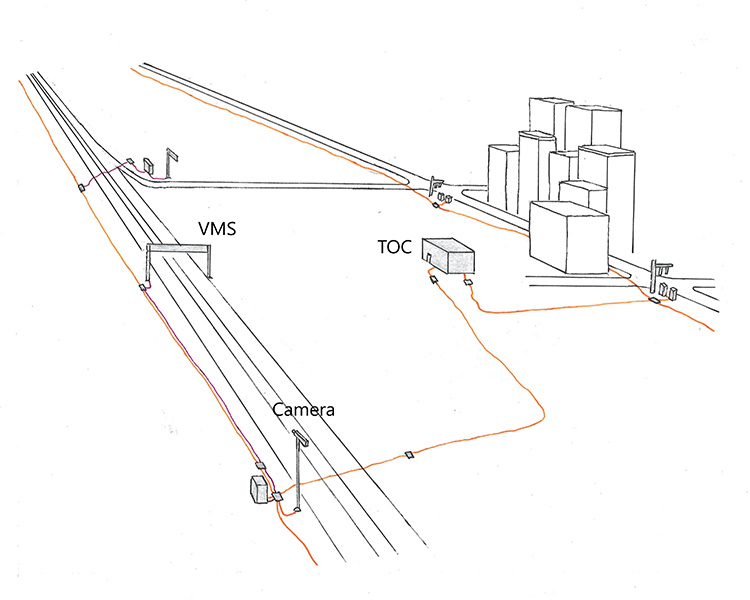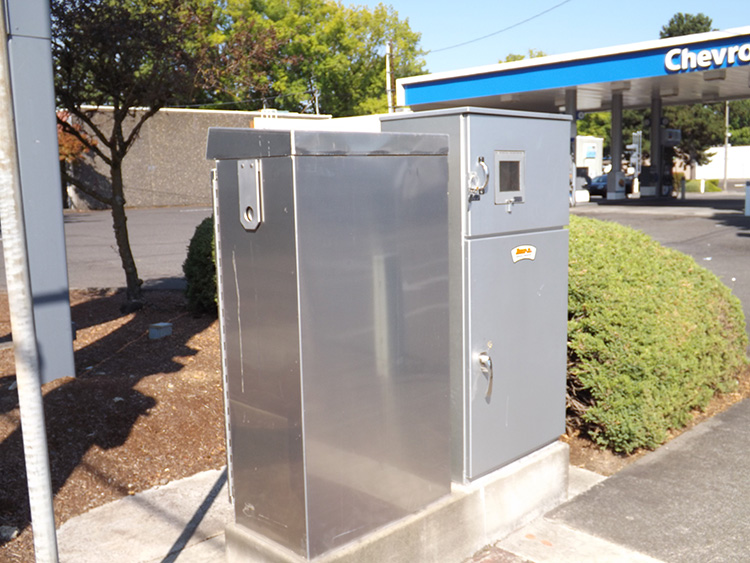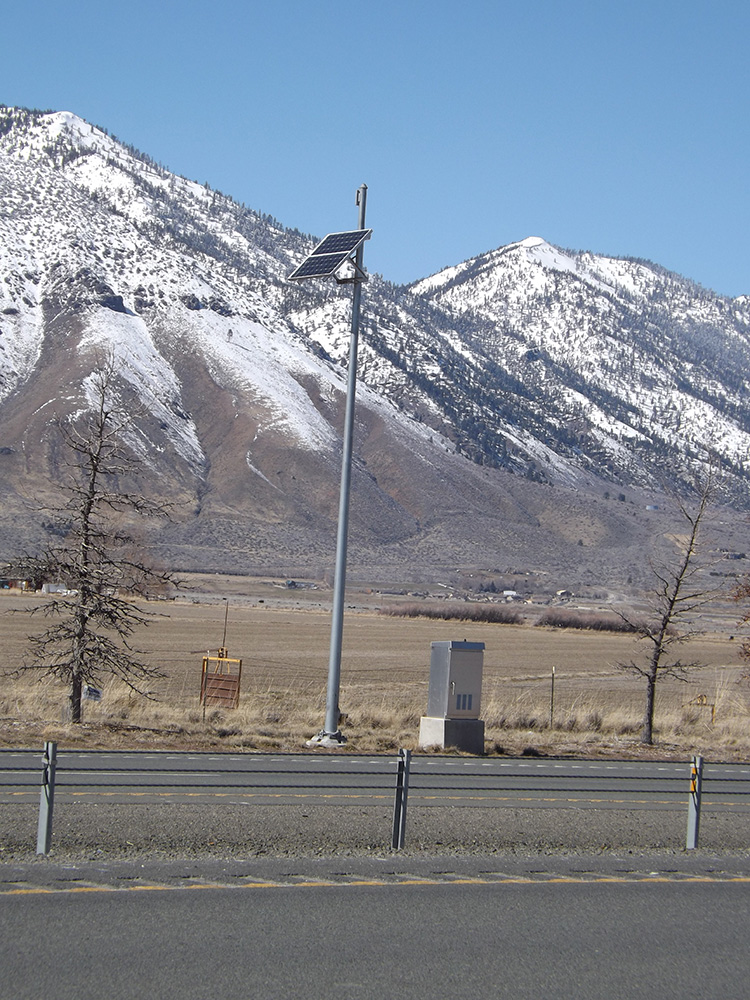ATMS
ATMS stands for Advanced Traffic Management System. The ATMS systems originated with the Federal Highway Administration as a way to improve traffic flow on interstates. In a few States the ATMS systems are called just TMS.
ATMS
ATMS stands for Advanced Traffic Management System. The ATMS systems originated with the Federal Highway Administration as a way to improve traffic flow on interstates. In a few States the ATMS systems are called just TMS.
 Any ATMS system is centered on fiber optic cable that typically covers the entire State on State Highways and freeways, with all of the fiber feeding to the Traffic Operations Center (TOC).
Any ATMS system is centered on fiber optic cable that typically covers the entire State on State Highways and freeways, with all of the fiber feeding to the Traffic Operations Center (TOC).The center of the plant is a building known as a TOC (Traffic Operations Center), and is operated by the local Department of Transportation (DOT). Canadian TOC’s will include a prior letter which indicates the city where the TOC is located, such as T-TOC for Toronto, and B-TOC for Burlington. American TOC’s are usually not identified separately by State, although they may be referred to as part of the local DOT such as MoDOT TOC for Missouri.
Inside the TOC there are a vast number of video monitors. Each of the monitors is connected to a video camera somewhere in the State (or Province in Canada). These are actual video cameras not vehicle detection cameras, so they transmit the real image of what is taking place on the street, though usually in a somewhat slide show format. The majority of them will be along an Interstate, but some may be on other State roads that feed into the freeway.
 VMS boards relay messages to the drivers on upcoming traffic conditions and other information.
VMS boards relay messages to the drivers on upcoming traffic conditions and other information. Not all messages are traffic related. Many DOT's use the VMS boards to encourage the use of seat belts.
Not all messages are traffic related. Many DOT's use the VMS boards to encourage the use of seat belts. Even in the worst of situations, the VMS boards can at least relay how long of a wait the drivers will have.
Even in the worst of situations, the VMS boards can at least relay how long of a wait the drivers will have.The purpose of the TOC is not only to receive input, but also to transmit output. This is done with VMS (Variable Message Sign) boards. Anyone who has ever set up traffic control to shut down a lane on a State road has probably found that part of the permit process includes making a call to the TOC just before the lane is shut down so that the TOC can alert drivers of the possible traffic problem. Even if the traffic control is performed in the middle of the night, the TOC will create a message that will then be displayed on any VMS boards they have that face traffic coming in to that particular area. An ATMS system can consist of a number of features, but its’ main features will consist of the video cameras, and VMS boards The cameras monitor traffic, and give the personnel at the TOC the capability to watch traffic events unfolding. The VMS boards are used to notify the drivers of upcoming conditions, the text on each board being easily typed out by a TOC operator. So, each TOC serves as a complete watch-and-respond unit.
Many DOTs even have specially designed vehicles for responding to freeway problems, often called Special Response Units with large caution light boards facing backwards. They can be dispatched by the TOC as soon as the accident occurs, and can show up at the wreck much faster than was previously possible. In some states they are even used to help drivers change a flat tire to get them off the freeway shoulder and reduce the risk of a crash.
 An ATMS cabinet being installed. The fiber cable has already been placed.
An ATMS cabinet being installed. The fiber cable has already been placed. This ATMS cabinet is being installed next to a pre-existing traffic cabinet. The timing of the traffic lights can now be adjusted from the TOC.
This ATMS cabinet is being installed next to a pre-existing traffic cabinet. The timing of the traffic lights can now be adjusted from the TOC.The VMS boards operate using regular traffic wiring, but the cameras use fiber optic cables. ATMS systems are centered on Interstates, but can connect with nearby intersection traffic systems as well. They may be limited to strictly cameras and VMS boards in some areas, while in other areas they may include traffic counters, electronic toll booths, weather stations along the Interstate, on-ramp traffic controllers, and a number of other features. They are becoming popular throughout the world, and can be found in Africa, Europe, the Middle East, Asia, and the Caribbean Islands.
There are a few states that have found the typical ATMS system to be too costly to fit their conditions. Montana is one the largest states, and yet it has one of the smallest populations in America. Instead of trying to pay for the high cost of placing fiber optic cable across the state, they instead went with radio operated ATMS. They have only a limited ATMS system throughout the State, though it does reach across the entire state. The features communicate with the TOC by radio waves from transmitters positioned near the VMS boards or cameras. This allowed them to install a basic system, but without the use of hundreds and hundreds of miles of fiber optic cable.
ATMS systems are controlled by cabinets just as intersections signals are. The typical layout will be every camera and VMS board in a particular area feeding in to the cabinet. The cameras use fiber optic cable, while the VMS boards operate on more standard traffic signal cable. At the cabinet the outgoing cable towards the TOC will be fiber cable though that TOC may in some cases be over a hundred miles away from the traffic features. The ATMS systems along freeways are usually placed in tandem, so one fiber cable feeds to the next cabinet, and then the next, and so on. In this way there is only one fiber cable or cable run for the entire system along any specific freeway, not a dozen different fiber runs for a dozen different cameras. Both the camera and VMS boards usually have their own pull boxes, usually near the base of the feature, and they may even be embossed with the letters ATMS or DOT. The cabinets usually have the larger hand holes, not pull boxes so they are quite noticeable.
ATMS cameras are often placed on separate poles along the freeway, though they may be attached to a bridge or other structure in some areas. With the cameras on very high metal posts, they do not always stand out that much from freeway lights unless you are watching for them, however, the VMS boards are impossible to miss. They are massive and extend out over the freeway.
 Two traffic cabinets side by side is a clear indicator that one is the regular traffic cabinet, and the other one (on the left) is the fiber connection from the TOC.
Two traffic cabinets side by side is a clear indicator that one is the regular traffic cabinet, and the other one (on the left) is the fiber connection from the TOC.Where ATMS fiber does connect with the local traffic system there will be two traffic cabinets, one for the ATMS, and one for the traffic system at that particular intersection. So, any intersection where two separate cabinets are side by side is an indication of an ATMS fiber connection in to that signal.
ITS
The ITS (Intelligent Traffic System) is actually a very broad term originated by the Federal Highway Administration, and was a group concept that included the DOTs to look at new ways to improve traffic flow in America. The ATMS system was originally a part of ITS planning back in 1991.
There are a number of features that may connect in with an ATMS system, or may be a stand-alone feature. This includes traffic counters, weather monitors, automated toll booths, pucks and newer features that are in development now. It is the overall concept of finding new ways to use technology to improve traffic that is ITS, not an exact system of features, but any innovate concept of improving the capabilities of traffic systems. Today it can be used to refer to a system that is even separate from the ATMS, and there are a number of experimental ITS features, but sometimes being experimented on in a single State.
 Small VMS board at entrance to a freeway.
Small VMS board at entrance to a freeway. Solar powered traffic cabinet.
Solar powered traffic cabinet. A small weather station in the country. Power comes from the nearby pole, but the information is radio transmitted to the TOC.
A small weather station in the country. Power comes from the nearby pole, but the information is radio transmitted to the TOC.